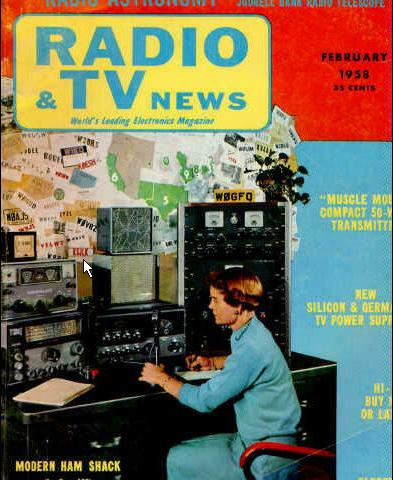The girl on our cover this month is Dorothy Hicks,
K0BRZ, who lives in Omaha, Neb. Dorothy is shown operating at WRL's
demonstration ham shack in Council Bluff, Iowa. Although she would
eventually like to have a home setup that is as elaborate as the one shown,
Dorothy's home station is a little more modest - a Johnson Viking
"Ranger", a WRL tri-band beam, and a National NC-300 receiver.
She does most of her rag-chewing, usually about three hours worth a day,
on 10 and 15 meter phone.
Dorothy really comes from a hamming family. Her
husband, Curt Hicks, is K0AMM. He is president of the Ak-Ser-Ben Radio
Club and is very active in local Civil Defense affairs. Much of his
hamming is with a mobile rig consisting of a 10-meter Subraco transmitter and
a PMR-6 Multi-Elmac receiver. Paul, one of their two sons, received his Novice
ticket when he was 11. His call is KN0GZJ.
Dorothy took her Novice and General Class training
at World Radio Laboratories' code classes. Her son was also trained here.
Novice training has been going on here for the past several years.
During last year, approximately 300 received their licenses and Leo Meyerson,
head of WRL, expects that almost double this number will receive their
licenses this year. As a matter of fact, the last group of trainees
(some 86 in
number) was so large that the group had to meet at one of the local
schools for adequate room.
The ham shack shown on our cover has been set up
for the convenience of customers who wish to keep a schedule while passing
through or simply for them to keep up on their hobby by seeing and using the
latest ham gear. Equipment is changed regularly so that over a period of
a year, just about manufacturer is represented. The ham shack is in
operation for about two hours a day and it is also available to Novice
operators who don't as yet have their own stations.
Equipment Shown
In the setup shown, Dorothy is speaking into an Astatic D-104 crystal mike
which is connected to the Hallicrafters HT-32 transmitter (center unit on
desk). A Vibroplex bug is nearby for c.w. operation. The transmitter is being
used here as a single sideband exciter with its output suitably reduced by a
power reducer network and applied to the r.f. section of the WRL "Globe
King" 500B transmitter (at right). The power of this transmitter under
single sideband conditions is 720 watts peak envelope power input to the
final. Since the 500B also contains its own exciter, v.f.o., and speech
modulator sections, this unit may be used independent of the separate
exciter shown here. As such, the "Globe King" may be used as a
complete phone and c.w. transmitter with band switching provided from 10
through 160 meters. The plate power input is 540 watts on either phone or c.w.
The Ht-32 exciter may also be used as a completely separate and independent
lower power standby transmitter. The unit provides single- sideband, phone, or
c.w. operation from 80 through 10 meters. The peak envelope power input is 144
watts. The output of the 500B is fed to a High-Gain 20-meter beam
through an external antenna relay. Atop the exciter unit are two
loudspeakers which are connected to the two receivers at the left. The upper
receiver is the Hammarlund HQ-110, a twelve tube super-het with dual
conversion. Full-dial coverage of the 6 to 160 meter amateur bands is
provided. The receiver provides an
Audio-Response feature that lowers the audio passband as the audio gain is
increased.
Thus the response to strong signals is broad band and to weak signals is
narrow band. Other features include crystal-controlled second conversion,
oscillator, Q-multiplier, crystal-calibrator, and separate linear detector for
SSB. The bottom receiver is the National NC-109, an eleven tube general
coverage unit tunable from 540kc to 40mc in four bands. A separate product
detector is used for SSB and c.w. reception. A gang-tuned r.f. stage, plus two
i.f. and two audio stages are used. The idea of using a pair of
receivers is so that a continuos civil defense monitor system can be employed.
In this case then, the HQ-110 may be used as the amateur band receiver while
the NC-109 may be used as the monitoring receiver. Tacked onto the wall
behind the equipment are some of the large number of QSL cards from hams that
have been worked from WRL.


73,
Bill Taylor K8TBW
705 Hart Ave. Fostoria, Ohio 44830
k8tbw@yahoo.com
HomePage
